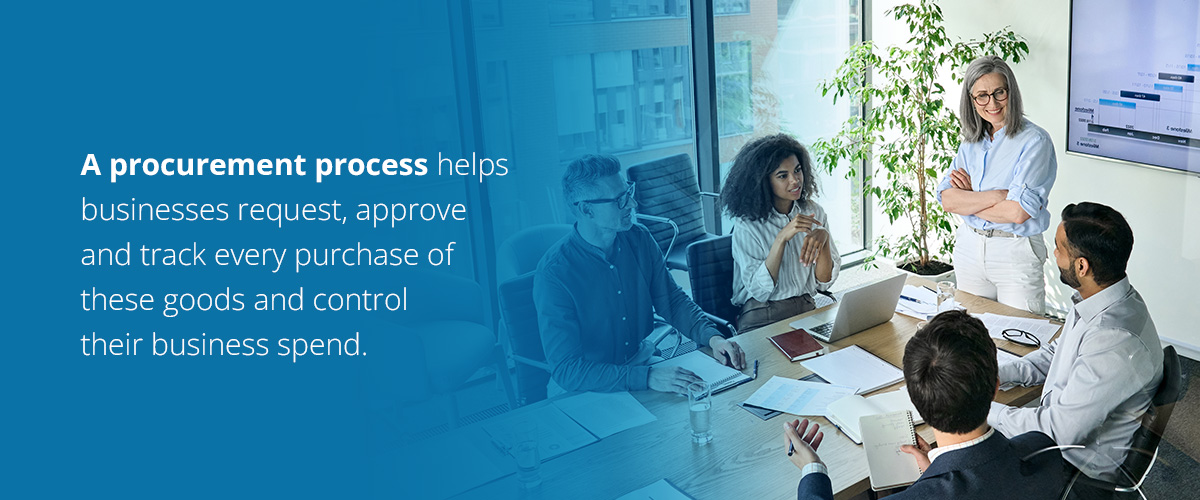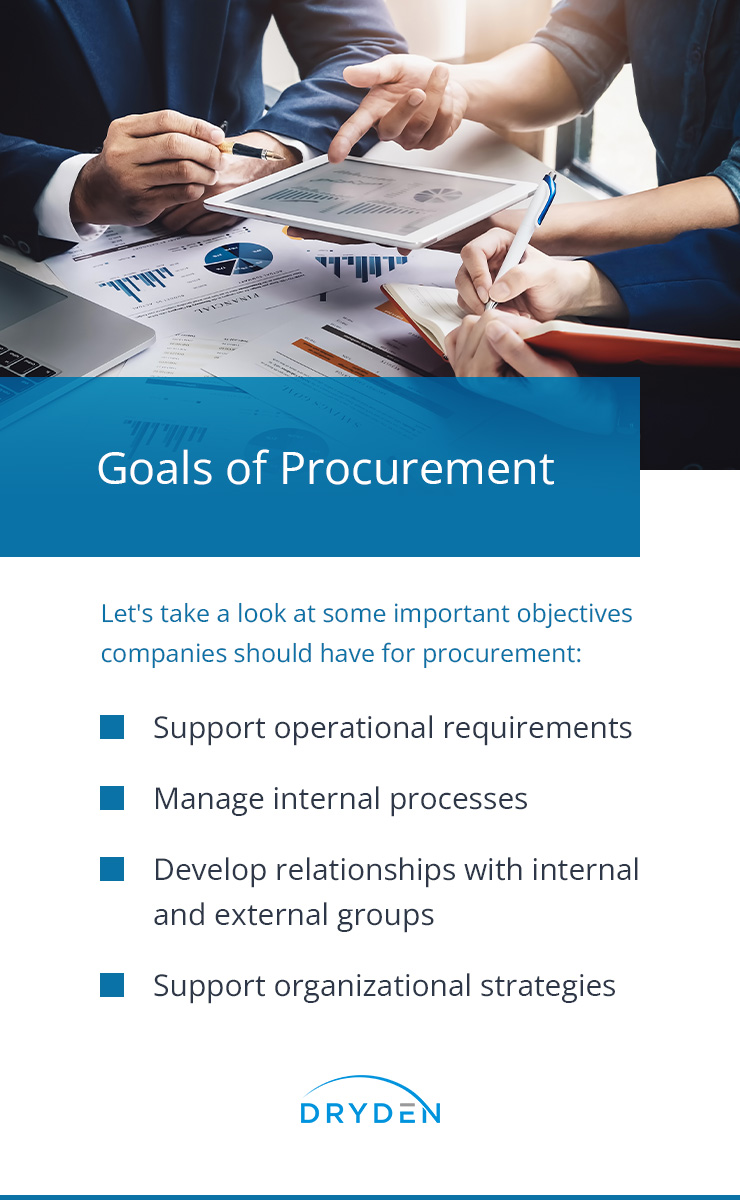What Is Procurement? (With Examples)
Last updated: July 8, 2022
In any business or organization, you need to manage many things to maintain your internal operations, consumer demand, product output and bottom line. How well your company manages procurement can significantly affect your profitability and reputation in each of these sectors.
Understanding the difference between procurement, purchasing, sourcing and other activities in these processes can help your teams determine how to allocate spending effectively and identify ways to save money. Below, we'll review the different types and goals of the procurement process, along with some procurement examples to help you learn more about this business practice.
What Is Procurement?
Whether an international corporation or a boutique startup, each business must rely on outside goods, services or suppliers to help maintain internal operations or produce the products they sell. That's where procurement comes in. Procurement encompasses a wide range of activities for sourcing, obtaining and purchasing goods, raw materials and services that allow companies to conduct business.
A procurement process helps businesses request, approve and track every purchase of these goods and control their business spend. Procurement also involves:
- Conducting market research.
- Determining needs based on market demand and inventory.
- Negotiating contracts and competitive bids with suppliers.
- Performing quality assurance on received materials, goods and services.
- Maintaining vendor and supplier relationships.
- Keeping a purchase order record to measure performance.
While some businesses define procurement as the entire process above, others reserve the term for activities strictly related to ordering, purchasing and making payments.
Companies can be on either side of the procurement process as sellers or buyers, depending on what they produce or manufacture. On the purchasing end, a business's procurement department sources supplies that offer the most affordable price for the most value. This team will focus on buying suitable materials based on company needs and budget.
The thought process during procurement is similar to customers' when purchasing a product online. The things that matter most to customers tend to be the product quality, how long they'll need to wait for delivery and how much value or use you will get out of the purchase. These concerns are precisely what companies consider in the procurement process, though on a much larger scale.

The Types of Procurement
Before businesses can begin a procurement process, they need teams to plan, strategize and determine a cost model for how they will pay for the materials or services. From here, procurement can be identified as either direct, indirect or services spend.
Direct Spend
When a company acquires tangible items, such as machinery, raw goods or wholesale materials to produce its own products, they engage in direct spend procurement. This type of procurement can also involve buying manufacturing services to create its own products. Direct procurement processes involve contracted suppliers and procurement officers and significantly impact the company's efficiency, performance and profitability.
Indirect Spend
Unlike direct spend, indirect spend focuses only on the supplies or services a company needs to function properly. Indirect spend procurement is when companies acquire or purchase goods that are necessary to conduct company operations. Since these goods and services will not connect to the production of a product or service, they do not directly relate to a business's bottom line or product output.
The indirect procurement process includes many items and services that businesses will use internally, including:
- Marketing services
- Office supplies
- Equipment
- Travel expenses
- Human resources
- Accounting and IT services
Services Spend
Similar to indirect spend procurement, services procurement is the process of purchasing internal or external services for business purposes. This type of procurement could include hiring temporary workers, consultants, short-term vendors or maintenance service providers. Businesses can also use this type of procurement for an event, seminar or short-term period for advertising, repairs or advising.
Procurement vs. Purchasing
While procurement and purchasing have many similarities, there are still some distinctions between the two concepts. Purchasing is a necessary component of the procurement process — without it, companies wouldn't have any supplies or services to manage. However, it's less complex and strategic than procurement. Procurement as a whole involves many different activities at once, including planning, budgeting, negotiations, purchasing and inventory management.
Let's review the other ways that procurement and purchasing differ.
Considerations
The purchasing process generally focuses on the price of the good or service rather than the business value. Since purchasing primarily revolves around company expenditure, the team involved with this activity must determine how the purchase affects the company budget.
On the other hand, procurement emphasizes the value of a good or service as it relates to the company's bottom line.
Tasks
The tasks involved in procurement differ from purchasing in many ways, and companies may have different processes for each activity. Procurement predominantly involves:
- Identifying the company's need for goods or services.
- Researching other sourcing options.
- Closing contracts with suppliers.
- Submitting and creating purchase requests and orders.
- Approving invoices and making payments.
In contrast, purchasing involves fundamental tasks related to obtaining the necessary items or services, such as:
- Purchase requisitions
- Ordering
- Receiving
- Payment processing
Impact
When it comes to suppliers and vendors, the teams behind a company's purchasing and procurement processes will concentrate on short- or long-term goals, respectively. The team or person responsible for purchasing activities will likely focus on the individual transaction with the goal of making it as successful and efficient as possible. The team or person behind the procurement activities will place more importance on developing a cordial, mutually-beneficial relationship with vendors and suppliers.

Goals of Procurement
The primary goal of procurement is for companies to fulfill their needs strategically, improving their bottom line and bringing value to their business. Procurement aims to identify the ideal options before settling into a contract with a vendor or supplier. Let's take a look at some important objectives companies should have for procurement:
- Support operational requirements: Businesses need to understand their needs so they can buy the right products and services at the right price, quantity and specifications.
- Manage internal processes: Procurement teams must identify areas where they can add value by mitigating risks, evaluating contracts, selecting suppliers and alternative materials and finding ways to save money.
- Develop relationships with internal and external groups: Companies should maintain timely communication and relationships with internal customers, suppliers and vendors to better understand business demands and requirements.
- Support organizational strategies: Procurement teams should develop intentional strategies that support other organizational goals and monitor the market for trends, price increases, changes in supply and shortages.
Indirect Procurement Process
The exact process for indirect procurement differs for every business because each one has its own needs, preferences and requirements. Let's review a general example of the indirect procurement process below:
- The company identifies a need.
- The procurement team writes up a purchase requisition for suppliers and vendors.
- The company reviews if there is enough funding and need for the order.
- Once they approve the transaction, the team negotiates contracts with the vendor.
- The company will cross-check its invoice to ensure accuracy when the goods or services arrive.
- Finally, the procurement team will create a record of all financial activities.
Within this general framework, there are more detailed activities that help procurement teams maintain operations.
1. Predicting Consumer Demand
One of the first steps in identifying your business needs is conducting market research. Knowing how to keep your customers engaged with your brand will help you quickly and efficiently deliver what they want. Before your procurement team can create a plan for ordering inventory or services, you need to predict fluctuations in customer demand and adjust accordingly.
To do so, you can use analytic tools like customer activity, current events, trends and data. It's important to be aware of any dips or spikes in demand so you can meet your consumers' expectations.
2. Selecting a Supplier
Choosing the right vendor or supplier for your goods and services is just as critical as making the purchase itself. A strong, positive relationship with your vendors can improve your procurement activities and help you manufacture your products faster than the competition.
First, you'll need to learn more about various suppliers before selecting one. Many businesses send out requests for information (RFIs) to learn more about vendors and suppliers, including their financial history and previous activities. Once you choose a supplier, you will need to evaluate your contract to ensure they will fulfill the details and expectations outlined in the terms.
3. Negotiation
Negotiation is an essential part of procurement that involves personal skills, strategies and business tactics to reach agreeable conditions for each party. When working with a supplier or vendor, it's important to establish terms for the price, quality and timeframes that benefit both sides. Some important negotiation strategies and skills include:
- Maintaining a base price instead of a range.
- Being willing to compromise and be flexible.
- Outlining non-negotiable factors.
- Establishing fundamental requirements.
- Keeping alternatives in place in case agreeable terms cannot be met.
4. Measuring Procurement KPIs
You'll want to measure your company's progress and performance before, during and after procuring goods and services for your business. Measuring progress is an effective tool for making adjustments if an element of the procurement process is not helping you reach your goals. The best way to measure success is using procurement key performance indicators (KPIs), which include:
- Employees: Determine if your employees are meeting productivity expectations. You may need to adjust your staff training for efficiency.
- Inventory: You'll want to measure your stock and fulfillment accuracy, inventory turnover and back order rates to see how your warehouse management contributes to meeting your goals.
- Supplier: Ensure your supplier's quality, compliance and availability are meeting your needs to maintain your performance and consumer satisfaction.
- Purchases and timeframe: The cost, lead time and cycle time it takes to fulfill purchase orders can directly affect your company's budget, product turnaround and bottom line.
- Return on investment: Measuring performance can help you optimize your return on investment (ROI) by revealing savings opportunities, cost avoidance techniques, competing suppliers and cost per order.

Indirect Procurement Examples
Since indirect procurement is unique to every business and organization, let's look at some indirect spend procurement examples to see what it might look like for your company.
In addition to the types of indirect procurement above, these activities can also include:
- Freight and logistics.
- Payments on utilities, including heat and electricity.
- Purchase of maintenance, repair and operation (MRO) to maintain equipment and processes.
- Employee training.
- Maintaining business hardware, including software programs, computers and phones.
You may have engaged in several types of indirect procurement in your business. While procurement is the act of acquiring or purchasing something through a stream of essential activities, it can also refer to your business identity.
Consider your company values and mission. What standards and ethics are important to you and your consumers? These standards directly intertwine with procurement. Procurement activities to obtain new goods and services for your business should align with your previous operational decisions and reflect what your company finds important.
For example, your business might value environmentally conscious standards and sustainably sourced products. The procurement policies and practices you put in place should ensure that you work with vendors and suppliers with similar ethics. Essentially, your procurement strategy should be the action behind the beliefs and philosophies your company thrives on when handling vendor relationships and procuring goods.
What to Look For in an Indirect Procurement Partner
With so many day-to-day operations and activities involved in the procurement process, it can be challenging for your business to stay on top of it all. Partnering with a procurement professional can help steer your business toward the performance and success you want to see. Your indirect procurement partner should guide you through every step of the process with a strong understanding of:
- Supplier relationship management.
- Category management.
- Indirect spend categories.
- Data-driven analytics.
- Spend statistics.
- Procurement consulting.
- Indirect spend benchmarking.
Need More Information on Procurement? Dryden Group Can Help
Whether you run an independent business or a large corporation, procurement is one of the most important activities to help your company thrive and meet its operational goals. At Dryden, our mission is simple — we want to help our customers gain a competitive advantage through increased procurement performance. As an indirect cost and spend management company, we offer procurement consulting services to help your business save on tools, goods and services.
Our industry experts utilize comprehensive data to help you reinvest in technologies and strategies that improve growth and innovation and transform your business. At Dryden, we can streamline your processes and assist you with supplier sourcing, relationship management and contract negotiations.
For more information about how our procurement services can help your business, contact us today, and we'll be happy to answer any questions.
